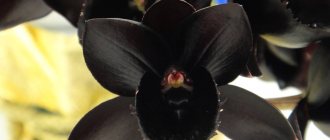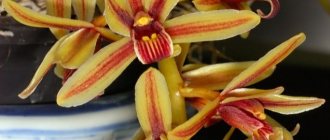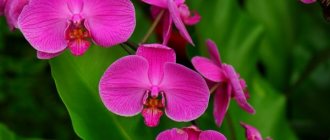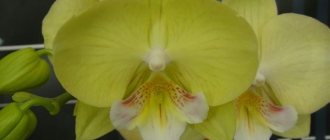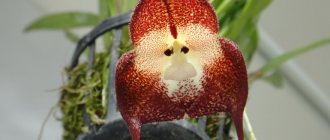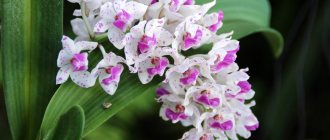Characteristics of black orchid
With regard to indoor floriculture, the Phalaenopsis genus is the most common of the Orchidaceae family. Their popularity is due to the fact that representatives of the genus are quite easy to care for. This genus has about fifty different species, all of tropical origin. Phalaenopsis orchids grow in exotic countries such as Taiwan, the Philippines and Australia.
Orchids are never completely black
The black orchid is an original flower. However, there is not much true black in nature. In fact, this shade is provided by special blue or purple pigments. Phalaenopsis black up close turns out to be dark burgundy or dark purple. But these flowers are still beautiful.
It is not surprising that Tom Ford created his famous perfume “Black Orchid” based on the smell of black orchid. Ford's Orchid is not even a fragrance, but a step towards bohemian luxury. It is worth noting that plants can have different shades. For example, Phalaenopsis variety Black Pearl may have pinkish-red, burgundy or dark purple petals.
Reality or myth: a flower shrouded in mystery
The global scientific community still cannot give a definite answer as to where this miracle of nature came from. There is a claim that the black orchid was discovered by George Cranleith (a naturalist botanist) on the South American continent. He stole the flower from local tribes, where the black orchid was considered a sacred untouchable plant. Having discovered that their totem was missing, the natives caught the thief and subjected him to terrible torture. Despite the fact that the scientist’s act was reckless, it was thanks to him, many believe, that humanity learned about a magnificent mysterious plant - the black orchid.
More pragmatic people are confident that the above story is a myth and in fact the black flower was bred by Californian scientists by selecting some varieties of phalaenopsis. Creating such a hybrid is a very complex process that requires significant financial investments. The main feature of the hybrid orchid is its aroma; it is rich in a hint of vanilla. Only hybrid phalaenopsis can be called a black orchid. Some gardeners use chemicals to color the inflorescence. To do this, a corner with a coloring agent is made into the peduncle of a white orchid, due to which the shade of the flower itself changes, as can be seen in the photo.
Scientists are sure that there are no black flowers in nature itself; such a pigment does not exist in principle. These are just very dark shades of violet, purple or burgundy.
Common varieties and varieties
Phalaenopsis orchid: main types and home care options
Even the so-called black orchids exist in several varieties and varieties.
Orchid Black Pearl
They differ in appearance and sometimes are completely different from each other. The most popular ones are presented below.
- Black bird
It has a rich blueberry hue. The flowers are located on one peduncle, they are large, with a waxy gloss. Flowering is very spectacular and long lasting.
- Black Prince
It has an almost inky tint. A characteristic feature is white spots in the center.
It can reach a height of up to 50 cm, the diameter of the flower is no more than 7 cm.
For reference! The number of colors Black prince has depends on the conditions of detention.
- Black Pearl
This black phalaenopsis orchid is the fruit of careful selection. Its flowers have a very unusual shape; the plant forms up to 4 peduncles. The color is burgundy with a slight purple tint, the leaves are a rich emerald color.
- Black Widow
A very attractive plant. The shade is very juicy, colorful, and you just want to touch the petals. The black orchid flower has an elegant shape.
- Not the most famous varieties of black orchid
Black Trevor, Black Mamba and Black Swan orchids are quite interesting varieties.
Orchid Black Trevor
They all need proper care, without which they will not be as attractive.
Phalaenopsis midi Black bird (Black bird) 2 stv
Phalaenopsis is native to the dense tropical forests of southern Asia (southern India, Taiwan and the Philippines), New Guinea and Australia. This biological species has up to seventy varieties, in addition, there are thousands more different hybrids and varieties. These are plants with greatly shortened stems.
The leaves are evergreen, 10-30 cm long, collected in a rosette from which flower stalks and aerial roots grow. For its color and shape of the petals, similar to the fluttering wings of a butterfly, this flower was called “orchid-moth” or “orchid-butterfly”.
You can find phalaenopsis with a single flower, as well as with many inflorescences that fit on one stem. The stem can reach a length of sixty centimeters and bear up to twenty inflorescences.
Phalaenopsis is the most unpretentious plant of the orchid family, and for beginners it is recommended to breed orchids from it.
Thanks to its lush and frequent flowering and excellent adaptation to indoor conditions, this plant has become the most popular of the genus of orchids grown indoors. Before purchasing, carefully inspect the plant: the roots should be green and silver.
Characteristics
Flower color purple Flowering period every six months Flowering duration 8 weeks Maximum height 30 cm.
Premises requirements
Lighting is bright, humidity is average, temperature in summer is +25+30C, in winter +18+25C.
Phalaenopsis needs an influx of fresh air, but it is important that there is no draft. Almost all species feel comfortable during the day from +22 to +30C, at night not lower than +16. Drafts and excessive heat are dangerous for the plant.
Cooler temperatures promote flowering, hotter temperatures promote the appearance of flowers on the peduncle. Phalaenopsis love bright light, and if there is no sun, you can use artificial light (fluorescent lamps).
Do not place the orchid in direct sunlight (burns are possible). At temperatures above +35° C, the orchid must be placed in a cooler place, and the roots and foliage should be sprayed with warm water.
Phalaenopsis requires bright light for at least 12 hours in winter. With insufficient lighting, flower growth slows down, and in winter the orchid may go into a dormant state.
For additional illumination, fluorescent lamps emitting a white glow are used. However, if you do not have the opportunity to additionally highlight the flower, nothing bad will happen.
Your orchid will actively develop in the spring-summer period and rest with the onset of winter.
In order for your orchid to bloom, a number of conditions must be met:
- move the flower pot as little as possible;
- do not allow sudden changes in temperature;
- provide the plant with sufficient light;
- Monitor the air humidity in the room.
You need to water with filtered, boiled or settled water, abundantly (by immersion), but rarely (in the summer once every 4 days, in the winter once every 7). Wait for the water to drain, remember that overfilling is much worse than underfilling. Irrigation water should not get into the growing point (the center of leaf growth) to avoid rotting.
Mostly mineral fertilizers with a certain level of acidity are suitable for phalaenopsis. Typically, fertilizers for orchids contain much less microelements than for ordinary indoor plants.
When choosing fertilizer, preference is given to liquid forms, as it will save you from the need to weigh and measure proportions.
In addition, pay attention to the presence of special ingredients that prevent the accumulation of excess salts.
Remember that for a healthy plant, the root type of feeding is preferable. For a plant with a damaged or practically absent root system, spraying can be carried out.
Transplantation is carried out mainly in the spring. In addition, the plant may need a new home immediately after purchase. For transplantation, you can buy a ready-made substrate. The orchid must be removed from the pot and the root system must be cleaned of the substrate.
Then you need to inspect the flower, remove yellowed leaves and rotten roots, treat the cuts with an antiseptic and dry the flower. It's best to let it sit overnight. The next day you can start transplanting.
To do this, take a new pot, place drainage in the form of expanded clay at the bottom, place the orchid in the center of the container and cover it with prepared bark. There is no need to fall asleep too much, remember that the roots need access to oxygen.
Reproduction of phalaenopsis at home is quite problematic. Often the formation of children on the mother's peduncle, which are then transplanted into the prepared substrate.
Among orchids, the most common diseases are those caused by improper care. In addition, phalaenopsis is very susceptible to rot, powdery mildew and fungi. The most commonly observed pests are mealybugs and citrus bugs.
Source: https://orchidea-shop.ru/katalog/dekorativnyie-tsvetyi/orhideynyie/falenopsisyi/falenopsis-midi-chernaya-ptichka-Black-berd-2-stv
Planting a plant
Phalaenopsis propagation at home: examples by children and cuttings
General tips and advice for caring for orchids apply to most plants on the market. These impressive flowers require basic care that is not that difficult. However, you need to know their specific preferences, such as amount of watering, required lighting, temperature, type of environment, etc.
Planting in a pot
Phalaenopsis orchids really need light, so you need to find a suitable place for proper flowering. For this reason, it is advisable to place them next to a window or terrace, but without direct rays. The ideal temperature should be around +22 ºC during the day and between +16 ºC and +20 ºC at night.
A plastic pot is usually a good choice because when it comes time to repot the plant, the plastic is much easier to separate and can even be cut off without problems to remove the roots as carefully as possible if necessary.
Attention! You cannot use regular garden soil for potted orchids.
Pre-made substrates are available from nurseries and garden centers and are usually made from cork, white peat, charcoal, vermiculite, polystyrene and coir. What all these materials have in common is that they are spongy, lightweight and resistant, capable of storing water and nutrients, maintaining optimal conditions for caring for orchid roots.
Phal. Miki Black Pearl DB1592
Payment
Payment by Privat Bank card only after approval of the order
- Characteristics
- Description
- How to make an order
- Payment
- Delivery
- Still have questions?
- Reviews (0)
Buy orchids from stock
- Registering and placing an order through the shopping cart is very convenient, since all your orders are saved in your personal account, you can also add bookmarks, view your purchase history, edit your requests for receipts, and also receive newsletters of all new products and sales. If you have already registered, you need to Login.
- Quickly place an order using the “Buy in 1 click” button - suitable for those who do not use mail; all communication takes place in Viber.
- Write the name of the variety in a private message to our community on Facebook.
- Write the name of the variety in private messages to our community on Instagram.
After receiving the order, we will provide a photo of the orchids to the specified e-mail or phone number or in private messages on social networks, within 24 hours. Please note that we do not take photos of teenagers, markdowns, or orchids in the range of up to 200 UAH, so expect only an invoice.
Pre-order
- Choose a convenient ordering method for you (listed above: e-mail, Viber or social networks)
- Confirm the terms of purchase. Pre-order orchids are plants that are not in stock and we will bring them especially for you.
- The order must be expected for a certain time and only after understanding the variety and the supplier’s response can we inform you of the approximate time frame
- We do not take photos of plants from the order, you receive the best specimens from those that we received from the supplier
- We, like you, do not see plants before paying, so if you want to see what you are buying, we strongly recommend that you refrain from ordering and buy a plant from stock
Please review the rules and evaluate the pros and cons before placing an order for plants from the Pre-Order category.
Orchids that are out of stock
You can submit a purchase request by clicking on the “Notify about availability” link. As soon as the variety becomes available - you will immediately know about it - a notification letter will be sent to your email.
Are you looking for a specific variety?
If you cannot find the variety you need on the website, please contact us via the feedback form and we will be sure to provide you with all the necessary information.
Are you looking for discounted orchids?
- Visit the Markdown, Sale section or choose budget options in the Everything for 200 UAH section
- Subscribe to our newsletter! To do this, you need to go to the main page of the site and enter your E-mail in the Subscribe to newsletter and promotional offers block. If you get tired of the newsletter, you can unsubscribe from the newsletter at any time.
You will be provided with an invoice for payment after processing the order, and also only after approval (if you were provided with photos of the plants).
Payment is made to a Privat Bank card, you can pay using the details or to a card account.
Watering
Orchid care at home: options for propagating and planting a flower
Watering is probably one of the most delicate aspects of orchid care. The water should be soft enough to almost completely eliminate tap water, which usually contains diluted salts. They concentrate in the substrate and roots of plants, disrupting their growth and flowering.
Watering the plant
Any description of the watering procedure says that it is advisable to use rainwater. But this is quite difficult, because few people will be able to collect and store water every time it rains.
As a substitute, you can use bottled water with a low content of mineral salts, sodium, and calcium. Orchids usually do not need much water to bloom.
Water should only be applied when the surface of the soil is almost dry. Therefore, you should do this about twice a week in spring and summer, during the hottest months; and once every two weeks in winter and autumn. During the period from March to October, it is advisable to add a small amount of special fertilizers to the water.
To water properly, follow these instructions:
- Orchids prefer a moderately moist substrate because if it is too wet, the roots cannot breathe and will rot.
- It is best to leave the substrate dry, watering it a day later. Therefore, the frequency of watering will depend on the ambient temperature.
- You can tell if the plant needs water if the substrate is dry to the touch or if the roots are whitish. If they are green, then no watering is needed.
- Watering should be plentiful, but without flooding the roots.
- The water should be at room temperature.
You should try not to wet the flowers to avoid stains. It is also necessary to avoid getting water on the surface of the leaves.
Attention! The orchid needs a high level of humidity, ranging from 60 to 80%.
Care
Having a tropical origin, this indoor beauty requires increased attention to itself. Caring for a flower is divided into equal segments, such as:
Substrate
For this variety, ordinary garden soil, of course, is not suitable. Important indicators when creating a substrate are considered to be high drainage capacity and good aeration. You can purchase a ready-made mixture at a flower shop. Having experience, you should mix the appropriate components yourself: crushed pine bark, soil, moss, pumice, etc. The ratio of the components should be approximately the same.
Temperature and humidity
Everyone knows about the whimsical nature of orchids.
As for temperature conditions, then, of course, one should take into account the importance of the constant difference between daytime and nighttime indicators. The difference between day and night temperatures should be stable and remain at 5-7 degrees
In general, the temperature range that is well accepted by flowers is 18-22 degrees.
Depending in part on temperature and watering methods, humidity plays an important role in the life of a flower.
In general, black Phalaenopsis like slightly moist soil, but do not overdo it.
Lighting, watering and fertilizing
Direct sunlight is contraindicated for a dark orchid, but diffused light, either morning or sunset, will benefit this variety of orchids.
There are several types of watering suitable for this species. Before you start moistening the flower, you need to conduct an external inspection of the condition of the plant.
The appearance of a flower can tell you whether it needs moisture
It is also important to check the soil moisture level
Methods:
The black orchid can be bathed under low pressure in the shower. This should be done for several minutes until the substrate is completely moistened. Afterwards, you need to allow excess water to drain through the holes in the container and leave the flower alone for 30 minutes. Repeat this procedure once every 2 weeks. In winter, you should stop swimming. Watering with a tray is the least labor-intensive way to care for a black orchid. The size of the pallet is selected according to the size of the flower. Take into account the height of the drainage system in the plant pot. Water is poured into the pan, and the root system of the precious species itself absorbs the required amount of moisture.
Also, this method provides the necessary air humidity around the flower, which is sometimes so important for its growth and good flowering. Immersion. This method is considered one of the best
The entire pot is slowly immersed in a container of water at room temperature. The time it takes to hold it under water varies from 30-50 seconds to half an hour. Then the moisture must be allowed to drain. Do not immerse all flowers in the same water to avoid disease transmission. Surface moistening and watering. This is applying water in a thin stream to the entire surface of the substrate until excess moisture begins to flow out of the holes.
Fertilization processes are activated during the active phase of flower development, which precedes the formation of the peduncle. During the flowering period, feeding should be suspended. During the dormant period, you should also not add additional nutrients to the soil.
Reproduction methods
Orchids can be propagated in two ways: cuttings or seeds.
Reproduction methods
Important! There is an opinion that to grow an orchid you can simply pick a leaf. Gardeners who talk about this method are actually mistaken - most likely, they accidentally tore off the leaf along with part of the trunk where the dormant buds were.
Unlike violets, leaves alone are not enough to grow orchids.
Reproduction through cuttings ensures that the new plant has the same genetic characteristics as its parent. The samples raised through seeds are not identical. Some species of the genus Dendrobium and Phalaenopsis themselves form small new plants.
Aerial roots emerge from the stem. When the roots reach a size of 3 to 4 centimeters, the new plant is separated, the wounds are healed with coal dust and placed in a pot.
Feeding and fertilizers
Providing nutrients to orchids is a good way to encourage natural growth and new blooms. Orchids should be fertilized during the growing season.
Feeding and fertilizers
As with watering, it is better to apply less fertilizer than more. Epiphytic plants have very few nutrients in their natural habitat.
Transplanting a plant
Epiphytic orchids rarely need a larger pot, however, it is important to refresh the substrate from time to time so that the roots breathe well and can dry evenly.
It is recommended to replant your orchid every two to three years, regardless of the condition. It is also important to pay attention to the types of orchid pots. If there are a lot of roots or they extend beyond the edge of the pot, then the plant definitely needs to replace the container. You also need to change the substrate if traces of fungi or rot are visible.
Before you start replanting, you need to make a small drainage (pebbles or polystyrene), the flower pot itself needs to be cleaned and disinfected.
Procedure for transplantation:
- To remove the plant, you need to press your hand on the surface of the pot to disconnect the roots. Then hit the base.
- Completely remove the old backing.
- Use disinfected scissors to cut off any dead roots.
- Disinfect wounds with coal dust or cinnamon.
After this, phalaenopsis can be planted in a new container on fresh soil.
Pests and diseases
Orchids need fresh air; care must be taken to ensure that the room in which they are located has minimal daily ventilation, but is not exposed to cold winter air.
Affected leaves
Air renewal is necessary in order to avoid the appearance of certain types of diseases, mainly caused by fungi.
Attention! High concentrations of moisture combined with high temperatures and polluted air provide ideal soil for the proliferation of fungi, bacteria and viruses.
The most common pests are snails and slugs, especially if orchids are in the garden. If any symptoms of disease are noticeable, it is recommended to contact a specialist garden center, where experts in the field can help and recommend remedies.
With proper care, a black orchid can bloom several times a year. In fact, Phalaenopsis orchids will adapt much better to indoor living than to outdoor conditions. And varieties with black flowers arouse constant interest among everyone.
Optimal conditions of detention
Exotic black phalaenopsis need conditions that are as close as possible to their natural habitat. For normal development and abundant flowering, they need moisture, sun and warmth, that is, conditions similar to a tropical environment.
When growing orchids, it is very important to provide them with the required temperature conditions. The most suitable temperature range is considered to be within 18-22°
Maintaining the temperature at the specified level will stimulate abundant and long-lasting flowering of plants. If the air temperature in the room where the orchids grow is inconsistent, then the phalaenopsis simply will not bloom.
No less important for phalaenopsis is moisture, which must be present both in the substrate and in the air. These tropical flowers do not tolerate moisture deficiency well, during which they begin to form buds less frequently and in smaller quantities. However, excess moisture can be no less harmful for these exotics. An excessively waterlogged substrate can lead to rotting of the roots and, as a result, the death of plants.
Gardeners consider the optimal level of air humidity when growing orchids to be 30-40%. If the air in the room is too dry, the leaves of the plants will begin to wrinkle, losing their juiciness and natural turgor. To prevent this from happening, phalaenopsis should be regularly sprayed with a spray bottle. A wide bowl of water located near the pots will also provide the plants with moisture.
It is important to ensure good ventilation in the room where exotics grow. Oxygen deficiency negatively affects both their condition and the duration of flowering
Regular ventilation will help ensure a flow of fresh air to the plants, during which orchids should be removed from the windowsill, preventing them from being in a draft.
Black orchids are very demanding of sunlight. Insufficient light is one of the common reasons why these exotics do not bloom. If daylight hours are less than 12 hours, then plants simply do not have enough time and energy to form buds and ripen them. To compensate for the lack of light, it is recommended to illuminate orchids with a fluorescent lamp.
However, in an effort to provide orchids with maximum illumination, we should not forget that direct sunlight can negatively affect the condition of delicate flowers and leaves.
